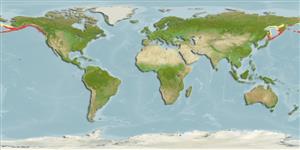Teleostei (teleosts) >
Perciformes/Zoarcoidei (Eelpouts and pricklebacks) >
Ptilichthyidae (Quillfish)
Etymology: Ptilichthys: Greek, ptilon = feather + Greek, ichthys = fish (Ref. 45335); goodei: Named after Dr. G.B. Goode, U.S. ichthyologist (Ref. 6885).
Eponymy: Dr George Brown Goode (1851–1896) was an American ichthyologist and museum administrator at the Smithsonian. [...] (Ref. 128868), visit book page.
More on author: Bean.
Environment: milieu / climate zone / depth range / distribution range
Ecology
Marine; demersal; depth range 0 - 360 m (Ref. 50550). Temperate; 66°N - 42°N
North Pacific: Japan, the Sea of Okhotsk, and the Kuril Islands to Bering Sea and to central Oregon, USA.
Size / Weight / Age
Maturity: Lm ? range ? - ? cm
Max length : 40.0 cm TL male/unsexed; (Ref. 56557); common length : 15.5 cm TL male/unsexed; (Ref. 56557)
Found at surface at night, evidently on the bottom in deeper waters during the day (Ref. 2850). Buries itself in mud or sand (Ref. 2850). Has been recorded to be found in the stomach of a coho salmon (Ref. 6885).
Life cycle and mating behavior
Maturity | Reproduction | Spawning | Eggs | Fecundity | Larvae
Eschmeyer, W.N., E.S. Herald and H. Hammann, 1983. A field guide to Pacific coast fishes of North America. Boston (MA, USA): Houghton Mifflin Company. xii+336 p. (Ref. 2850)
IUCN Red List Status (Ref. 130435: Version 2024-1)
Threat to humans
Harmless
Human uses
Tools
Special reports
Download XML
Internet sources
Estimates based on models
Preferred temperature (Ref.
123201): 0.9 - 8.3, mean 4.4 °C (based on 378 cells).
Phylogenetic diversity index (Ref.
82804): PD
50 = 1.5000 [Uniqueness, from 0.5 = low to 2.0 = high].
Bayesian length-weight: a=0.00102 (0.00046 - 0.00225), b=3.06 (2.88 - 3.24), in cm total length, based on all LWR estimates for this body shape (Ref.
93245).
Trophic level (Ref.
69278): 3.4 ±0.5 se; based on size and trophs of closest relatives
Fishing Vulnerability (Ref.
59153): Low to moderate vulnerability (30 of 100).
